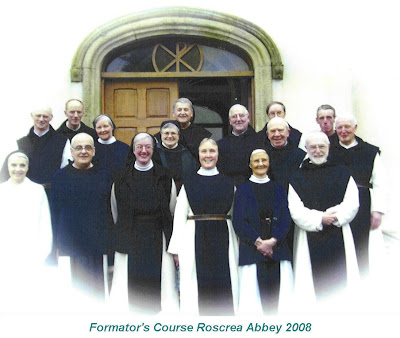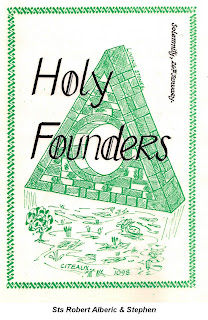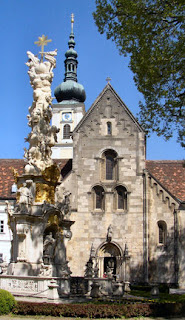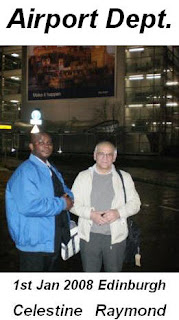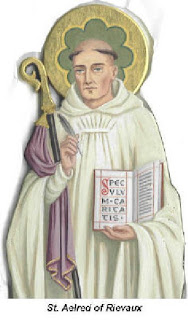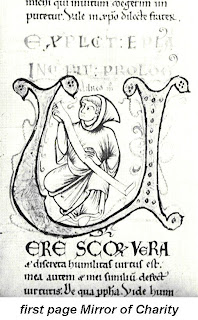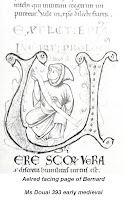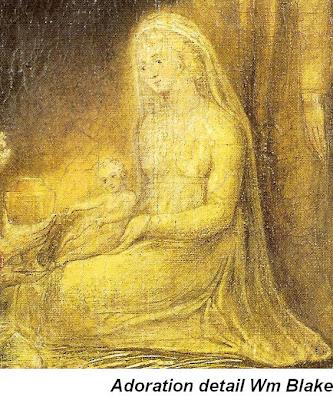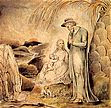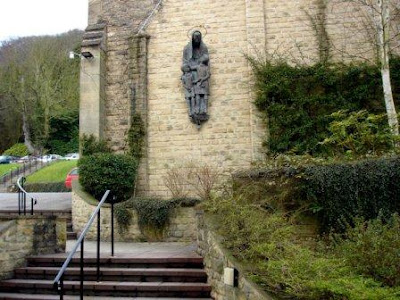
Maurus and Placid –Further Thoughts.
The 15 Jan 2008 Post on Maurus and Placid has prompted further thought and comment.
The comment about, “Going back to the alleged, “We do not know anything about Maurus and Placid”, it is not true”, much was left unsaid, and in fact it appears there is even more unsaid way beyond the fascinating questions that arise. The point in our Mass Introduction was simply on the Beauty of Holiness, and in particular in the memory of Saints Murus and Placid.
The exclusive preoccupation with written records, now being replaced by adulation of the technology of the digital data banks, can easily cloud perception and sensitivity to the obvious living tradition and continuity in ordinary human transmission of memory, community experience, the physicality of churches, monasteries, shrines etc. The random example of a St. Maurus is but a link in the chain of the life stream of monastic life-history. In that connection, the amazing development of the Maurist Congregation is but another revealing link. The bricks and mortar of ancient monasteries speak volumes. How much louder is the voice of the Beauty of Holiness in the lives that shine through this rich and varied awareness of Saints.
The picture of the Scottish ‘Maurus and Placid’ brings some interesting feedback.
To the community and boys at Fort Augustus Abbey the statue was simply a representation of St. Benedict in an EBC Cowl as patron of the boys at the school. Dom. F., OSB, was kind enough to send the picture of the stone sculpture now located at a suitable site in the Ampleforth Abbey buildings. He wrote that,
“The statue of St. Benedict and two boys came to Ampleforth, where five of the remaining monks of Fort Augustus had joined the community.
It is now erected on a building wall adjoining the monastery and church. A photo attachment is sent with this email.
It is interesting that you saw this as a modern rendition of St. Benedict and Sts Maurus and Placid. That makes a lot of sense. However, I am not aware that this was ever seen as the significance of the statue at Fort Augustus . It was a school icon primarily, and not a monastic one. Hence the boys are in kilts, and the younger is looking to the elder – the descending hierarchy of authority in the school. And both are under St. Benedict (with EBC hood!).
However, Sts. Maurus and Placid fit well.”
Very Helpful. Let me acknowledge; “Many thanks for your kind Email.
Thank you for the picture of the stone sculpture of St. Benedict transferred to Ampleforth.
It is quite unique, and apart from its new Yorkshire location, could not find a more suitable home than Ampleforh Abbey.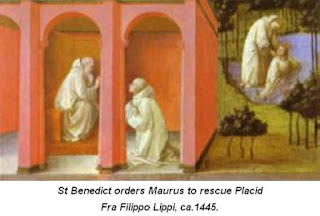 It will be interesting to compare more traditional iconography of Sts. Maurus and Placid.
It will be interesting to compare more traditional iconography of Sts. Maurus and Placid.
Iconography: St. Benedict orders Saint Maurus to the rescue of Saint Placidus. Fra Filippo Lippi, ca.1445.
If there is a Scottish touch to the stone sculpture above, the attached painting seems to show that Fra. Filippo Lippi had a lending to the Cistercians – the white cowls.
Who wrote the Dialogues of Gregory the Great?
All of this has brought me to questions of my own!
If Gregory the Great wrote the Moralia of Job why should literary critics take exception to the hagiographical style of the Dialogues to the extent of denying that Gregory was the author of the Dialogues?
If his scriptural exegesis in the Moralia was thoroughly symbolic, could he not equally well adopt the hagiographical genre of writing in the Dialogues?
Could he not be as versatile as he was accomplished in authorship of both styles?
The allegation of his "promoting superstition" in his stories of, e.g., the miracles of St. Benedict, only seems to indicate the lack of an understanding of the religious outlook of the context.
The scholarship of Francis Clark has succeeded in putting these issues to fore. In spite of the Internet Highway, one drawback is the cost of access. Amazon lists his book, The Gregorian Dialogues, at £182.66.
See Clark, Francis. The "Gregorian" Dialogues and the Origins of Benedictine Monasticism. Leiden, Netherlands: E. J. Brill, 2003. Updates the controversy and refutes attempted rebuttals of the 1987 work. (The Pseudo-Gregorian Dialogues. 2 vols. Leiden, Netherlands: E. J. Brill, 1987).
and its Note: “This book condenses and updates the author's two-volume work, "The Pseudo-Gregorian Dialogues (Brill, 1987), surveying and clarifying the controversy which that work rekindled. It presents the internal and external evidence showing cogently that the famous book which is the sole source of knowledge about the life of St. Benedict was not written by St. Gregory the Great as is traditionally supposed, but by a later counterfeiter.It makes an essential contribution to the current reassessment of early Benedictine history. It also throws much new light on the life and times of St. Gregory, and confutes the age-old accusation that he was "the father of superstition" who by writing the "Dialogues corrupted the faith and piety of medieval Christendom”.
A gentler introduction is that of
Petersen, Joan M., THE DIALOGUES OF GREGORY THE GREAT IN THEIR LATE ANTIQUE CULTURAL BACKGROUND
Finally, returning to the peace of thoughts on the Beauty of Holiness in the tradition of Gregory is this extract:
The Holiness of Gregory
by James J. O'Donnell
(ccat.sas.upenn.edu/jod/holiness.html#1)
In the Dialogi, the central figure is undoubtedly Gregory, but the interlocutor is of scarcely less importance. It is rather a question of the holiness - - and here the word is not quite the right one -- of the readers of the Dialogi. In emulating Gregory and Peter, they become themselves not saints, not warrior heroes of the soul: but they acquire the 'discernment' (that monastic discretio that so dominates Gregory's catalogues of the virtues to be undistracted by the world and its temptations and to emerge from that world relatively unscathed.
Properly read, then, Gregory's work valorizes not Gregory's holiness but that of his reader. It is a holiness that the Christian reader of Gregory's text learns to acquire through a text. The Dialogi themselves deny 'miracle' a central place very early on: Dial. 2.37, 'hinc ergo, fratres carissimi, hinc certa consideratione colligite, oblata a nobis hostia sacra quantum in nobis soluere ualeat ligaturam cordis, si oblata ab altero potuit in altero soluere uincula corporis.' In short, the most 'popular' of Gregory's works, the Dialogi and the homilies on the gospels, leave the reader in a world, that is to say a text, where holiness is breaking through everywhere, uncontrollably. 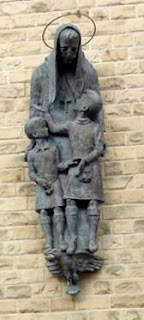 I mean the holiness that is physically present through the eucharist. Though eucharistic liturgy was increasingly dependent on texts in Gregory's age, it was still then (and in many ways is still now) a venue for holiness that resists reduction to text and narrative. 'Interiority' is a persistent theme of every modern study of Gregory's thought, and rightly so. Holiness is everywhere, holiness is at the altar, and holiness is deep inside the individual.
I mean the holiness that is physically present through the eucharist. Though eucharistic liturgy was increasingly dependent on texts in Gregory's age, it was still then (and in many ways is still now) a venue for holiness that resists reduction to text and narrative. 'Interiority' is a persistent theme of every modern study of Gregory's thought, and rightly so. Holiness is everywhere, holiness is at the altar, and holiness is deep inside the individual.
 member in New Testament, whom he had not previously met, told the story of how he stumbled on a copy of the book as a novice Cistercian monk in the Knockmealdown mountains of
member in New Testament, whom he had not previously met, told the story of how he stumbled on a copy of the book as a novice Cistercian monk in the Knockmealdown mountains of 

